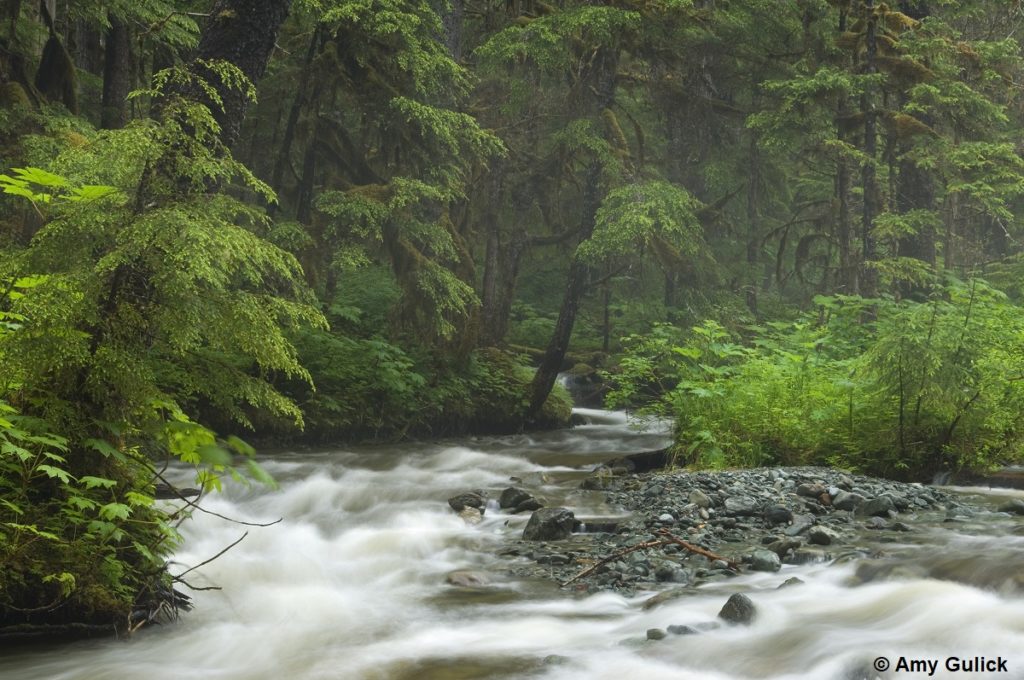The forest within: Finding wisdom in the woods

Author Amy Gulick joined us recently on Geography of Hope to share stories from the Tongass National Forest. Below, she discusses “finding wisdom in the woods.”
By: Amy Gulick
(This article originally appeared on Outdoor Photographer.)
Stepping off pavement and onto the spongy forest floor, I feel like Alice in Wonderland entering through the looking glass into an alternate reality. Gone is the crush of deadlines, the overflowing email inbox and the cluttered calendar. Here my pace is natural, moving through the forest on foot at the same rate that all humans moved when we first came down from the trees and stood upright. I inhale the aromas of moist dirt and sweet blooms. The laughing cackle of a robin makes me grin, and the echo of hooves springing off the ground reveals the back end of a deer in flight. A light mist cleanses the air and my mind.
This immersion into my wooded surroundings is a practice known as shinrin-yoku, Japanese for “forest bath.” It’s long been known that being in nature bestows many health benefits upon those who spend time outdoors. Medical doctors have even begun to prescribe forest bathing as a remedy to reduce anxiety, elevate mood and boost energy levels. For me, it’s a time to be present and connect with the real world. My brain slows, distractions disappear, and I can focus on things that are happening now.

Being aware of our natural surroundings is how our not-so-distant ancestors survived in the wild. Knowing every animal and its behavior kept us fed and alive. Knowing which plants could cure and which could kill was essential. Today, someone with this knowledge is called a “naturalist,” specializing in a field of study foreign to many of us. This isn’t surprising when the average American, according to a study by the Environmental Protection Agency, spends 93 percent of his or her time in enclosed buildings and vehicles. Yikes.
I’m a firm believer that we haven’t lost this knowing of nature. We’ve just stopped putting it into practice, and so we’re a bit rusty. But it’s still there, waiting for us to tap into the wellspring of our wellbeing. We just need to get out and practice shinrin-yoku.
The forests where I live in the Pacific Northwest are known for their dense understories, multi-layered canopies and long-lived conifer tree species, including western red cedar, Douglas fir and Sitka spruce. A diversity of wildlife lives among the riot of green, but many species can be difficult to see, especially small flitting birds. Over the years, I have learned to identify my local birds just by sound. It happened partly by necessity and mostly by being in the forest on a regular basis and — here’s the kicker — by paying attention. I now know, just by its calls, when a dark-eyed junco is defending its territory or when it’s agitated. If I hear the loud rustling of leaves on the ground, it’s a good bet that the spotted towhee is raking the underbrush. And there’s no mistaking a fly-by from the feisty rufous hummingbird — the buzz of 50 wing beats per second sounds like a fist-sized bee.

I also know the forest through senses other than sight and sound. My taste buds seek the seasonal gifts of tart red huckleberries, citrusy spruce tips and meaty fungi. My nose knows when skunk cabbage is in bloom, an animal has died and a cedar tree has split open. A bed of soft, springy moss can cradle my weary body, and the thorny stalks of devil’s club have taught my hands to mind what I grab.
Being in the forest activates a sixth sense, too — one of awareness. Scientists refer to it as proprioception: an awareness of how our bodies are positioned and move in space, which helps our brains navigate the world. I’ll take this a step further. Spending time moving through the forest has helped me see that the deer, plants, fungi, birds and the bees are all connected in a glorious cycle of life. And that in death there is life — plants and animals feed each other, and fallen trees provide nutrients and shelter.
Just as no tree is a forest, no man is an island. We are relational beings who need each other as well as a multitude of other species. We are a part of nature, whether we live in a forest or a concrete jungle. It’s only in our minds that we detach ourselves from what breathes life into us. And it’s in our minds where the wisdom of the woods plants itself, waiting to grow.
Amy Gulick is an award-winning nature photographer and writer, and a fellow with the International League of Conservation Photographers. Her images and stories have been featured in Audubon, National Wildlife, Sierra, Outdoor Photographer, The New Republic and other publications. Her work in Alaska has received numerous honors including the prestigious Daniel Housberg Wilderness Image Award for excellence in still photography, film or video from the Alaska Conservation Foundation; the Voice of the Wild Award from the Alaska Wilderness League; a Lowell Thomas Award from the Society of American Travel Writers Foundation; and a Philip Hyde Grant Award from the North American Nature Photography Association. Her new book is call “The Salmon Way: An Alaska State of Mind.” Her previous book, “Salmon in the Trees: Life in Alaska’s Tongass Rain Forest,” won an Independent Publisher Book Award and two Nautilus Book Awards. Watch her full Geography of Hope episode here.
The views expressed here are the writer’s and are not necessarily endorsed by Alaska Wilderness League.
